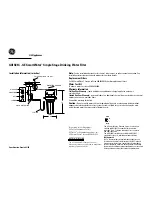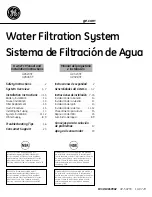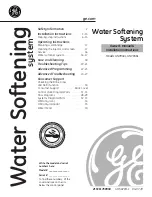
8
10.
Plug ballast into an approved Ground Fault Circuit Interrupt (GFCI) receptacle. Where a 2-prong or
unprotected 3-prong receptacle is encountered, it must be replaced by a properly grounded Ground Fault Circuit Interrupt
(GFCI) receptacle. Installation must be in accordance with the National Electrical Code and any local codes and ordinances
by a qualified Electrician.
11. Once the plumbing hook ups are made, it is a good practice to disinfect the “downstream” plumbing between the purifier and
point of use. This is done by introducing chlorine or other disinfectant solution directly into the purifier chamber, a 100-
ppm of chlorine is suggested. With the disinfectant solution in the purifier chamber, turn the ultraviolet purifier on. Open the
“downstream” outlet until a chlorine or disinfectant solution odor is noticed. Close the outlet and allow the disinfectant to
remain in the plumbing for at least three (3) hours. Flush the plumbing with ultraviolet purified water; allow the water to run
for a minimum of 5 minutes before use (to ensure no chlorine or disinfectant solution smell can be detected), this will allow
the chlorine or disinfectant solution to be flushed through the pipes.
12.
For added protection, a suitable drain pan must be installed under the purifier. The drain pan must
be plumbed to an adequate, free flowing drain to prevent water damage in the event of a leak. There are numerous leak
detection/flood stop devices, available on the market today, designed to stop the flow of water, reducing the chance of water
damage due to leakage. For more details regarding leak prevention and/or limiting damages due to leaks, please contact
the factory.
r
eCommended
o
Ptions
1.
SENTRY
TM
Safety Sensor:
Indicators provide constant visual monitoring of normal operation. In the event of ballast or lamp
failure the safety sensor indicates an alarm condition. The safety sensor is capable of operating an optional audio alarm and/
or solenoid valve.
2.
Promate
TM
Audio Alarm:
Activated by the Ultraviolet Monitor or Safety Sensor, alerts the user to any malfunction detected.
3.
Promate
TM
Time Delay Mechanism:
Provides a 2-minute warm up period during which the ultraviolet lamp achieves its
full germicidal output before the water is allowed to flow through the water purifier. The time delay mechanism is used in
conjunction with, and is electrically connected to the Solenoid Valve.
4.
Promate
TM
Solenoid Valve:
Operated in conjunction with the Ultraviolet Monitor, Safety Sensor or Time DelayMechanism,
this valve prevents water flow through the water purifier when an abnormal condition is detected or in the event of
power failure.
5.
SureFLO
TM
Flow Control Valve:
Limits water flow to the rated capacity of the purifier. The flow control valve is located
in line prior to the water purifier, and should be protected from ultraviolet exposure by the use of a 90-degree elbow fitting
between the flow control valve and the water purifier.
Unless otherwise specified PVC flow control valves are supplied.
Stainless Steel Flow Control Valves are available for certain
models. All PVC and Stainless Steel flow control valves are male
NPT. Consult Factory for other flow control valves
6.
Promate
TM
Elapsed Time Indicator:
A non-resettable display of the water purifier operating hours. Useful for scheduling
and recording maintenance and lamp replacement.
7.
Promate
TM
Safety Goggles:
Safety eyewear should be used as general-purpose safety protection and for additional shielding
from ultraviolet rays
8.
Promate
TM
Stainless Steel Wall Mounting Kit:
Provides professional finish. Pre-drilled and ready for quick and easy
mounting of water purifier. Suitable for wall or surface mounting.
9.
Promate
TM
Face Shield:
Adjustable headgear and light weight visor provides eye and face protection from ultraviolet rays.
NOTE: The recommended options above are available from Atlantic Ultraviolet Corporation
®
or a distributor of their
products. For the other devices that may be required for your application, please contact your local water treatment
dealer, plumber or plumbing supplier.
Step 3 - Install Nut on Stud against
Washer & Tighten with 7/16” Wrench
Step 2 - Slide Ring Terminal Wire
Assembly onto Stud & Lock Washer
over Ring
Step 1 - Install Nut on Stud


































